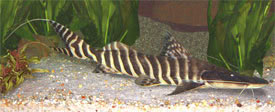
 Magyarul / Hungarian
Magyarul / Hungarian



- Scientific name: Brachyplatystoma tigrinum
- Synonyms: Merodontotus tigrinus
- Common name: Zebra Shovelnose, Tigrinus Catfish, Tiger-stiped catfish
- Group: Catfishes
- Habitat: South America; Colombia, Peru and Brazil.
- Size: 50-60 cm
- Biotope: Inhabits fast-moving parts of main river channels, including rapids.
- Social behavior: Peaceful, but will eat smaller fishes. It is territorial among its own kind and other large catfish.
- Diet: Carnivorous, all types of live foods: erthworms, mussels, small fishes. Also take care not to overfeed them. An adult specimen needs only a single feeding per week at most.
- Breeding: Not successful in an aquarium
- Tank: Minimum 650 litres
- Population: 1 fish for 1000 litres
- Decoration: Use sand as substrate. Build hiding places from rocks and roots. The water must be spotless and very high in dissolved oxygen. The fish need a massive current int he tank.
- Temperature: 24-28 °C
- pH: 6.8-7.6
- Hardness: 5-12 NK°
- Lifespan: 15 years
Description: To many catfish lovers this is the ultimate species to own, but its high price makes it uncommon in the home aquaria. It's often confused with Brachyplatystoma juruense, especially when juvenile, but Brachyplatystoma tigrinum has more defined patterning, has shorter barbels and has bigger adipose fin. Many of the specimens available to the trade are caught as juveniles and grown on in local holding facilities before exporting them. The head is elongated and compressed, becoming narrower to the front, and the lower jaw is shorter than upper. They have small eyes on the top of the head. The base color of the body is yellow to white with black vertical stripes from the dorsal fin to the end of the caudal fin. Head area from snout to insertion of dorsal fin, devoid of stripes. They do not tolerate high nitrates well and may stop feeding because of such conditions, so regular water changes must be taken.
























